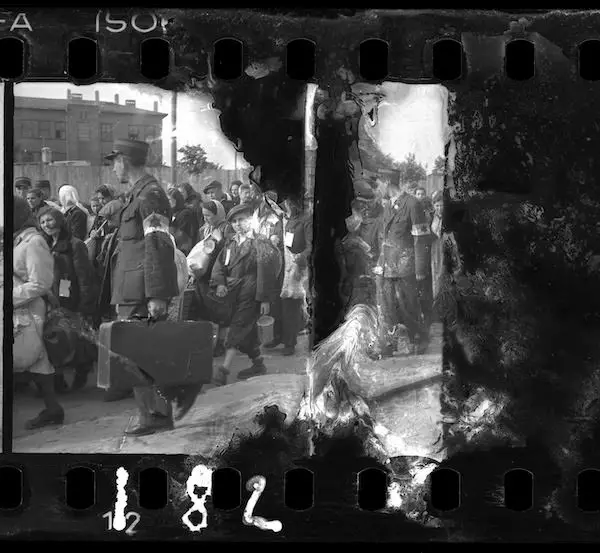Recovered like buried treasure after the Second World War, the photographs of Henryk Ross survive to tell the hidden story of the Lodz Ghetto. Two hundred of these photographs are on view now at the Museum of Jewish Heritage — A Living Memorial to the Holocaust. The exhibition is called Memory Unearthed: The Lodz Ghetto Photographs of Henryk Ross.

Photographer Henryk Ross lived in the Lodz Ghetto in Poland from 1940 to 1944. Enlisted to help the Jewish Council’s Department of Statistics, Ross photographed the ghetto, documenting its productivity and taking pictures for identification cards. Off-duty, Ross also took photographs in secret during his time in Lodz. These images, around 3,000 of them in total, depict the wide variety of people persisting through harsh conditions.

Ross’ photographs on view at the Museum of Jewish Heritage are slice-of-life images charged with the urgency of survival. Some are simple portraits of spouses or parents and children (some have speculated that these are members of the more powerful Jewish families in the ghetto). Others depict hunger, tight spaces, and strife. Still others evoke happy moments like birthdays, weddings, laughter, and kisses. The residents of Lodz strove to honor traditions and maintain happiness, even fleetingly, in what seem to be hopeless circumstances.
Lodz, the largest German-operated ghetto besides the one in Warsaw, saw around 200,000 Jewish residents at its height. They lived in a part of the city without a sewer system, with little running water or heat, and cramped housing. Jewish and Roma residents were expected to continue Lodz’s legacy as a textile hub by making uniforms and mattresses, among other products. Throughout the five years of this ghetto’s operation, citizens were transported out and sent to concentration camps like Auschwitz-Birkenau and Chemno to be killed.
In 1944, Henryk Ross buried 6,000 negatives of his off-the-record photographs, hoping someone would find them after the war. At this time the Nazis were actively purging Lodz of its citizens, and Ross assumed he too would be headed to Auschwitz. Ross hoped someone would find his photographs and develop them for posterity.
However, when the Soviet army arrived to liberate Lodz in 1945, Henryk Ross was one of 800 survivors still living there. He himself dug the negatives out of the ground. Half of them had held up in the frozen Polish soil. In addition to appearing in various publications, some of these photographs were later used to accuse former Nazis like the top SS official Adolf Eichmann. Ross, who died in 1991, lived to the age of 81.
Click here to take $5 off your admission to the Museum of Jewish Heritage—good for up to two adults.
The Museum of Jewish Heritage — A Living Memorial to the Holocaust is located at the tip of Manhattan in the Financial District. Behind the U.S. Holocaust Memorial Museum in Washington, D.C., it is the second-largest Holocaust museum in the nation. The MJH keeps an impressive archive of tens of thousands of artifacts and multimedia, on view for visitors year-round. 36 Battery Place; to buy tickets and learn more, call 646-437-4202 or visit mjhnyc.org.





